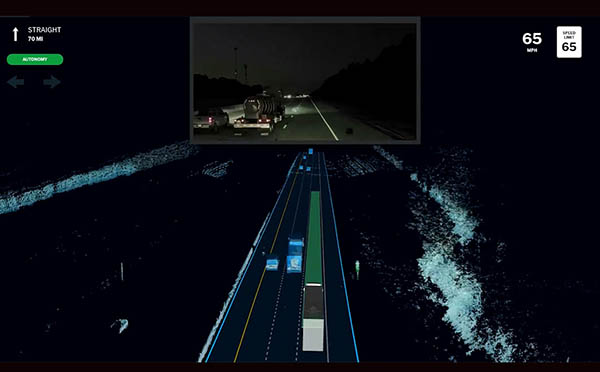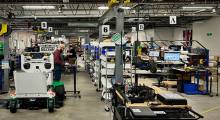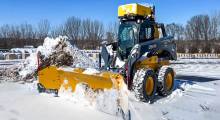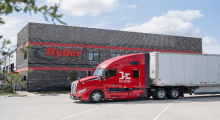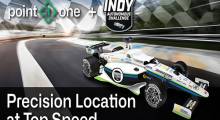Aurora this week released the first commercial beta of its Aurora Driver, which consists of the hardware, software, and data services needed to safely operate autonomous vehicles. The beta is currently hauling loads between Dallas and Houston in a commercial pilot of Aurora Horizon, a suite of subscription services to help carriers and fleet owners move goods more safely and efficiently.
Founded in 2017, Aurora said its mission is to deliver the benefits of self-driving technology safely, quickly, and broadly. The Pittsburgh-based startup's Aurora Driver platform is designed to autonomously operate passenger vehicles, light commercial vehicles, and heavy-duty trucks.
Aurora has partnered with companies including Toyota, Uber, Volvo, and PACCAR. Last year, it acquired Uber Advanced Technology Group (ATG), and It recently announced that it will merge with special-purpose acquisition company (SPAC) Reinvent Technology Partners Y and be publicly traded starting Nov. 4.
Aurora marks milestones to commercialization
Aurora said it is moving quickly toward the commercial launch of Aurora Horizon in late 2023, and the release of Aurora Driver Beta marks an important milestone. It demonstrates Aurora’s autonomous driving capabilities, confirms its driver-as-a-service business model, is the result of years of hard work, and is the foundation for future products, said the company.
The beta of Aurora Driver follows the company's “Self-Driving 2.0” approach to investing in the creation of technologies built for rapid deployment and scaling. The commercial pilot with FedEx and PACCAR along a 400-mile freight corridor came after just a few weeks of refining the Aurora Driver in simulation and testing on a 30-mile section of the I-45 between Dallas and Houston.
The beta release includes updates that allow autonomous trucks to navigate new commercial routes and transport goods for customers. Aurora said it includes improved hardware and autonomy systems capable of safely navigating highways and streets.
Aurora this week also announced the launch of its industry advisory council, which will review the company’s product offerings and go-to-market and regulatory strategies to help deliver value to all stakeholders in the logistics and transportation ecosystem across drivers, fleet owners, and local and federal governments. It includes the folllowing members:
- Andrew H. Card, former White House chief of staff and secretary of transportation
- Richard Stocking, former president and CEO of Swift Transportation; principal and CEO of DPX Consulting
- Craig Dickman, former president, CEO, and director of Paper Transport; founder and chairman of Breakthrough Fuel; and managing director of TitletownTech
- John Esparza, president and CEO of the Texas Trucking Association
- John Larkin, former managing director of transportation and logistics at Stifel; strategic advisor and advisory board chair at Clarendon Capital
- Steve Viscelli, author of The Big Rig: Trucking and the Decline of the American Dream; faculty fellow and lecturer at the University of Pennsylvania
Sensor fusion for safety
Trucks integrated with the Aurora Driver come equipped with Aurora’s proprietary FirstLight lidar, imaging radar, and high-resolution cameras. The Aurora Driver uses early sensor fusion to process data from all of its sensors at once, feeding its perception system a comprehensive view of the environment.
The self-driving developer said its sensor suite allows the Aurora Driver to track velocities and measure the acceleration of vehicles hundreds of meters away while moving at highway speeds, enabling faster, more accurate responses to road conditions.
Aurora Driver-powered trucks must safely autonomously handle all kinds of complex situations while hauling goods from city to city. These include unprotected left and right turns, high-speed merges, and various forms of construction, which are notoriously difficult for self-driving vehicles.
The company said Aurora Driver Beta performs such maneuvers reliably in stop-and-go traffic, while negotiating with other traffic, and even when faced with rare events such as people walking their dogs on a busy freeway.
Aurora Driver Beta is not just a development release; it is also designed to operate commercially for Aurora’s logistics partners, said the company. To date, Aurora’s commercial pilots “have delivered with 100% on-time arrivals, demonstrating autonomy performance that exceeds customer expectations,” it said.
Aurora works with Pixar vets to improve simulation
Aurora is also collaborating with the team at Colrspace – a start-up made up of Pixar veterans behind the computer-generated imagery (CGI) of movies such as Toy Story and Cars. Colrspace combines computer graphics and machine learning with a data-driven approach to reconstructing 3D objects and materials, deployable in real-world environments.
Colrspace's Protocolr innovation is based on an input image and infers texture and other material properties of an object. Key to the process is a neural network that models the processing of the camera pipeline. It couples this with a differentiable image renderer to enable “inverse rendering,” which computes the 3D scene and materials that would produce an image identical to the input photo.
With its Virtual Testing Suite, Aurora runs millions of simulations every day. The company said this allows it to train the Aurora Driver’s software stack across a vast range of scenarios and driving conditions to find edge cases and catch errors early, well before the software is loaded onto vehicles.
Ultimately, simulation testing drives the development of the Aurora Driver. Aurora said it and on-road testing are the quickest and safest ways to train and test its self-driving technology – estimated to be equivalent to more than 50,000 trucks driving continuously.
As Aurora continues to expand its Virtual Testing Suite, Colrspace's technology will bring scalability and increased accuracy to the high-fidelity virtual worlds that underpin the company's sensor simulation capabilities. Aurora noted that the more realistic the virtual worlds are, the more effective testing can be.
“We’re able to move quickly because of the smart foundational investments we’ve made in our technology and the immensely talented people who join our company,” said Chris Urmson, co-founder and CEO of Aurora. “Colrspace's team and technology will enable us to move even faster in developing simulation and machine learning tools, accelerating our progress towards delivering the Aurora Driver.”
Article topics
Email Sign Up

